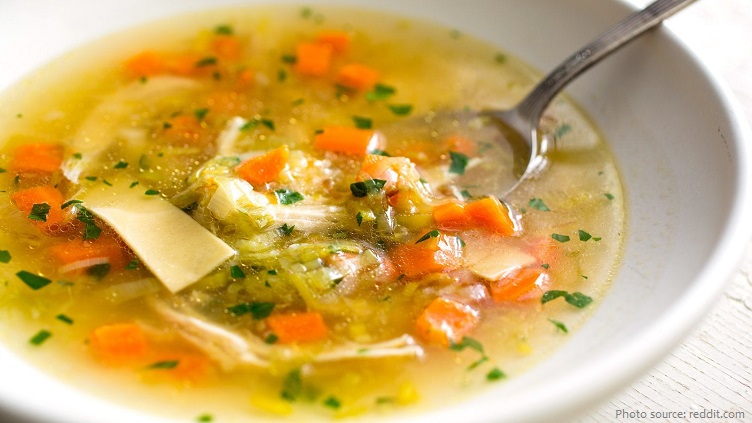
Chicken soup is a soup made from chicken, simmered in water, usually with various other ingredients.
The classic chicken soup consists of a clear chicken broth, often with pieces of chicken or vegetables – common additions are pasta, noodles, dumplings, or grains such as rice and barley.
Chicken soup is considered to be one of the healthiest dishes in the world.
It has acquired the reputation of a folk remedy for colds and influenza, and in many countries is considered a comfort food.
Chicken broth is the liquid part of chicken soup. Broth can be served as is, or used as stock, or served as soup with noodles. Broth can be milder than stock, does not need to be boiled as long, and can be made with meatier chicken parts.
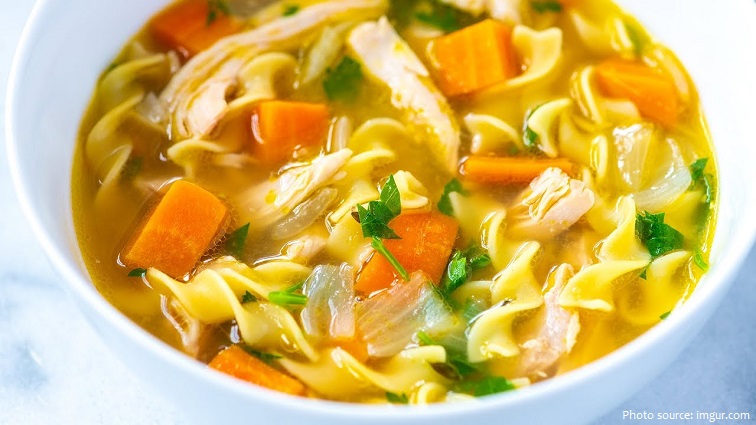
Humans were already boiling food by the time that chicken was domesticated in the neolithic period, so it is likely that chickens were being boiled for soup.
Broth was considered a restorative in the ancient world. Chicken broth’s special identification with health may have been due to the humoral system of medicine. According to the theory, broth had qualities that eased digestion. As thin foods were believed to be easier to digest, broths were specifically recommended for the sick. Also, the color of chicken soup was similar to the human complexion and was consequently considered nourishing.
Whatever the cause of the original belief, it survived into the Middle Ages: Chicken broth was commonly believed to be healthful throughout the Mediterranean and Western Europe.
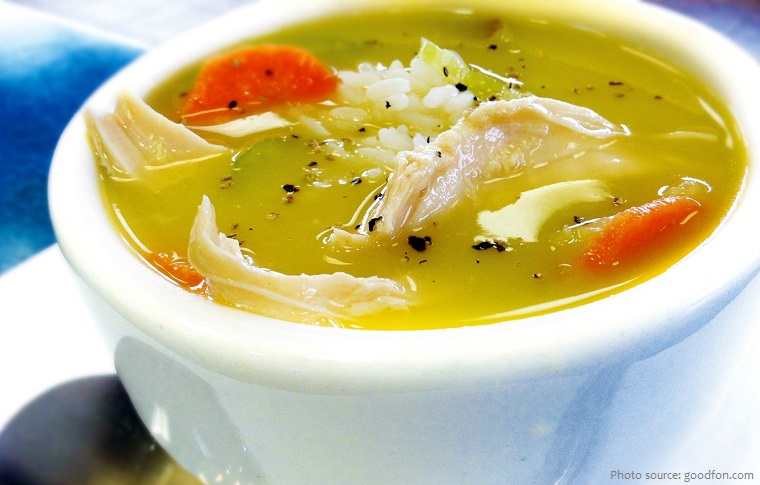
Moslems were particularly taken with chicken broth, as were the Jews. For instance, the classical Persian philosopher and physician Avicenna (980–1037) and the Jewish rabbi, physician, and philosopher Maimonides (1135–1204) regarded chicken soup as beneficial for the ill. This belief survived in Western culinary traditions, particularly those of Jews in Eastern Europe.
Chickens were employed in soup-making in England from the earliest days, and soup recipes containing chicken were regularly published as medical prescriptions.
Europeans introduced chickens into the Americas, and chickens were used in soup-making from the 16th century onwards. In the United States, recipes for soups containing chicken were published since 1824. However, the actual term “chicken soup” was not commonly used until the late 19th century. American manufacturers produced and promoted various commercial chicken soups, the most common of which was chicken noodle soup.
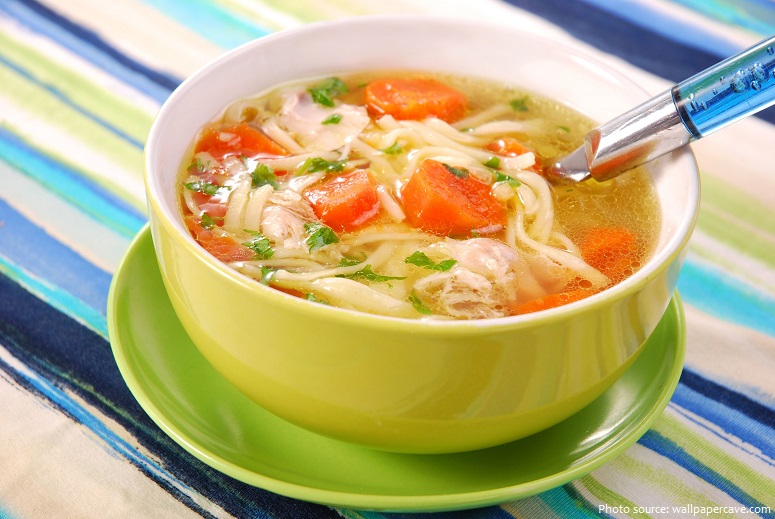
In 1993 Jack Canfield and Mark Victor Hansen compiled a book titled Chicken Soup for the Soul, which built on chicken soup’s healthy reputation and set in motion the publications of dozens of “chicken soup” books, including the first cookbooks solely focused on making chicken soup. Some scientific evidence has surfaced to support the belief in the healthful qualities of chicken soup: In addition to protein and vitamins, recent research has suggested that chicken soup does have a naturally occurring peptide that has positive influence on health.
Chicken soup is a traditional dish of the European Jewish kitchen. The Russian and Polish Jewish communities use a relatively high proportion of chicken stock for their soup, made mostly from the bones.
The soup is prepared with herbs like parsley and fresh dill or thyme, and is often served with knaidlach (matzah balls), kreplach (dumplings), lokshen (flat egg noodles), or mandlen (Shkedei Marak in Israel) (soup “almonds”). A traditional garnish was eyerlekh (little eggs). These unlaid chicken eggs were taken from a hen and boiled in the soup. Modern health standards make these difficult to obtain now.
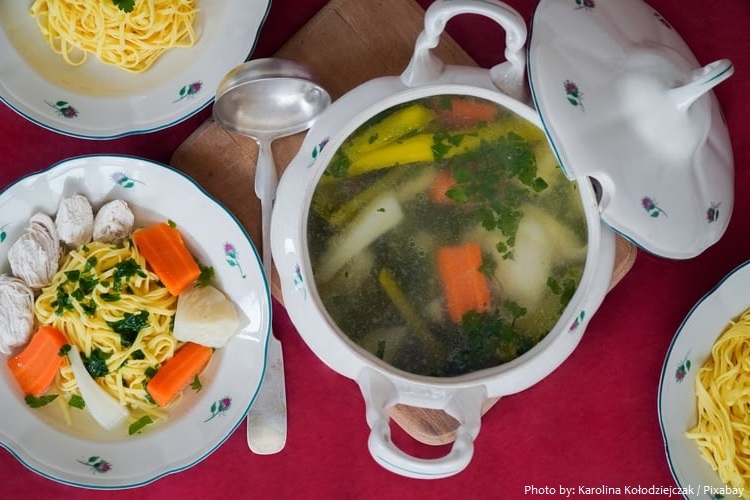
In the United States and Canada, chicken soup often has noodles or rice in it, thus giving it its common name of “chicken noodle soup”.
Traditionally, chicken soup (or broth) in Britain is a clear and watery soup with chunky vegetables (such as carrot, celery and onion), chicken, salt and pepper.
The French serve chicken-based forms of bouillon and consommé. Typical French seasonings for chicken soup includes: bay leaves, fresh thyme, dry white wine and garlic.
In Germany chicken soup is made with chicken broth, vegetables, such as carrots, spices and herbs and small noodles.
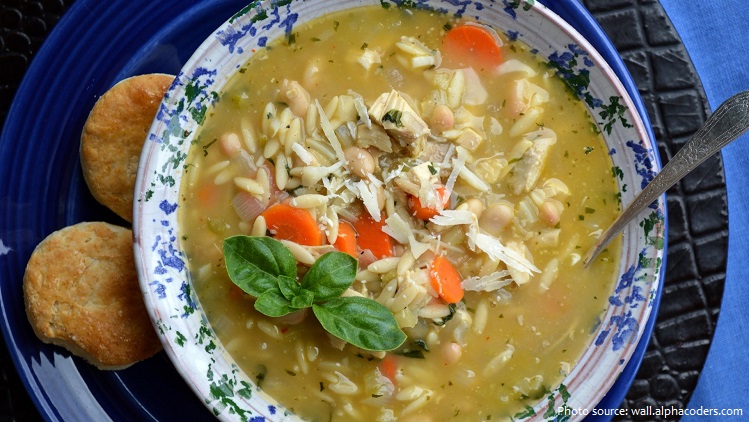
Hungarian chicken soup is a clear soup, a consommé, called Újházi chicken soup. A consommé with entire pieces of chicken, chicken liver and heart, with chunky vegetables and spices like whole black peppercorn, bay leaves, salt and ground black pepper. The vegetables boiled along with the pieces of chicken are usually carrots, celeriac, parsley root and parsnip.
In Japan, chicken soup is known as torijiru. Typically it starts with dashi, which is made from boiling konbu (kelp) and katsuobushi (dried skipjack tuna flakes), and not by boiling the chicken (whole chicken is not typically available in Japanese supermarkets). After the dashi is prepared, pieces of boneless chicken thigh meat are usually used and combined with vegetables like daikon radish, carrot, burdock, konnyaku, welsh onion, mushrooms, potatoes, and taro root. At the end, different seasonings are added depending on the region of the country or type of soup. It could be a miso-based soup or soy sauce-based. Cooking sake, mirin, salt, and vinegar are also used with the soy sauce or miso. The pork equivalent called butajiru is more popular than the chicken-based soup.
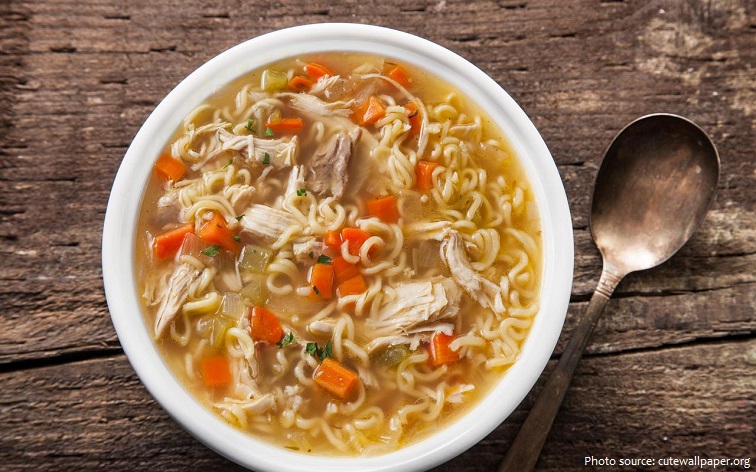
Many Chinese soups are based on chicken broth. Typical Chinese chicken soup is made from old hens and is seasoned with ginger, scallions, black pepper, soy sauce, rice wine and sesame oil.
Chicken soup is a great source of healthy, easily digested calories, with heaps of added nutritional benefits. There are 36 calories in 100 g of chicken soup.
Chicken soup is rich with essential fatty acids and protein. Both help your body build and repair healthy muscle, bone, skin, and blood cells. Chicken broth is also a rich source of minerals like iron. It also contains selenium. That helps prevent and manage cardiovascular diseases and complications, including strokes, and high cholesterol.
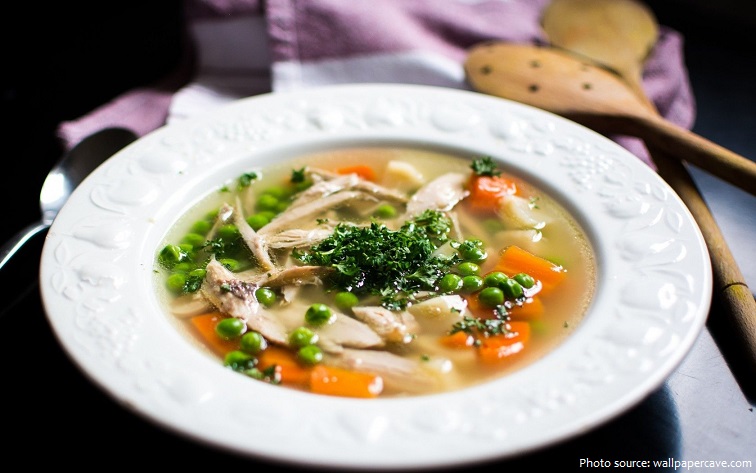
The word “soup” comes from French soupe (“soup”, “broth”), which comes through Vulgar Latin suppa (“bread soaked in broth”) from a Germanic source, from which also comes the word “sop”, a piece of bread used to soak up soup or a thick stew.
The word “chicken” was originally ciccen in Old English (a language that, like Italian, turned its Cs into CHs when they came before an I), but back then, it was just the plural of “chick,” and only referred to group of the baby birds. The -en plural is mostly dead in English, and has been for hundreds of years, but we still have words like “oxen,” “children,” and “brethren” to remind us of the loosey goosey olden days. By the 19th century, though, the word had become what we know today, and became the standard name for the bird, no matter the sex or age, dead or alive.